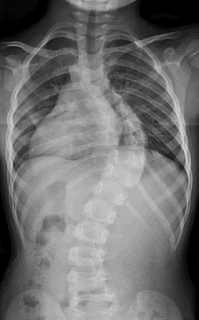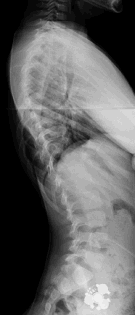1.
What is the Shilla procedure? The Shilla
technique is one which passively guides spine growth, rather than actively distracting
across like a growing rod system. I
refer to it as a “track and trolley” system.
What is the Shilla procedure? The Shilla
technique is one which passively guides spine growth, rather than actively distracting
across like a growing rod system. I
refer to it as a “track and trolley” system.
2.
Who is a candidate for the Shilla
technique? Many patients who are
candidates for traditional growing rods (GR) are also candidates for the Shilla
technique. The decision between GR and
Shilla technique will be made between the surgeon and parents/caregivers
focusing on what is best for the child.
Who is a candidate for the Shilla
technique? Many patients who are
candidates for traditional growing rods (GR) are also candidates for the Shilla
technique. The decision between GR and
Shilla technique will be made between the surgeon and parents/caregivers
focusing on what is best for the child.
3.
How is it different that traditional growing
rods or MAGEC? The Shilla fixes the
worst part of the deformity, that part of the spine which is growing more
sideways than vertically. By
straightening out the severely curved part and then fusing the apex of the
deformity the apex will be permanently improved. A traditional growing rod or
MAGEC system fixates above and below the worst part of the spine deformity and
creates small fusions in the part of the spine which is growing more
normally. The growing rods are then
forcefully distracted to put the spine under tension. See reference #1 below for more details.
How is it different that traditional growing
rods or MAGEC? The Shilla fixes the
worst part of the deformity, that part of the spine which is growing more
sideways than vertically. By
straightening out the severely curved part and then fusing the apex of the
deformity the apex will be permanently improved. A traditional growing rod or
MAGEC system fixates above and below the worst part of the spine deformity and
creates small fusions in the part of the spine which is growing more
normally. The growing rods are then
forcefully distracted to put the spine under tension. See reference #1 below for more details.
4.
Is Shilla better than traditional growing rods
or MAGEC? To this surgeon, if a Shilla
can be used over a traditional growing rod or MAGEC then it is my first
choice. The question is why? The initial surgery is similar between all
three surgeries in terms of recovery.
The benefit of the Shilla is there is no need for repetitive surgeries,
unlike traditional growing rods, or frequent clinic visits, as is necessary for
MAGEC. Overall, when Shilla is compared
to growing rods the overall outcome on x-rays is nearly identical. Another benefit is Shilla patients undergo
1/3 the number of surgeries/anesthesia when compared to traditional growing
rods. See reference #2 below.
Is Shilla better than traditional growing rods
or MAGEC? To this surgeon, if a Shilla
can be used over a traditional growing rod or MAGEC then it is my first
choice. The question is why? The initial surgery is similar between all
three surgeries in terms of recovery.
The benefit of the Shilla is there is no need for repetitive surgeries,
unlike traditional growing rods, or frequent clinic visits, as is necessary for
MAGEC. Overall, when Shilla is compared
to growing rods the overall outcome on x-rays is nearly identical. Another benefit is Shilla patients undergo
1/3 the number of surgeries/anesthesia when compared to traditional growing
rods. See reference #2 below.
5.
Is the spine fused in a Shilla procedure? A spine fusion is performed typically over
2-4 vertebra where the scoliosis is at its worst. These vertebra were not growing normally anyways. Even if the patient had received a
traditional growing rod or MAGEC that very curved part of the spine would not
grow normally.
Is the spine fused in a Shilla procedure? A spine fusion is performed typically over
2-4 vertebra where the scoliosis is at its worst. These vertebra were not growing normally anyways. Even if the patient had received a
traditional growing rod or MAGEC that very curved part of the spine would not
grow normally.
6.
How long will the Shilla procedure last? In the
2nd paper listed below it was demonstrated that they average patient
underwent 3 surgeries: initial, one revision and then one final surgery. The average patient underwent a revision
surgery at 3-3.5 years after the first surgery and then final surgery at 6-7
years after the first surgery. Every
patient is different.
How long will the Shilla procedure last? In the
2nd paper listed below it was demonstrated that they average patient
underwent 3 surgeries: initial, one revision and then one final surgery. The average patient underwent a revision
surgery at 3-3.5 years after the first surgery and then final surgery at 6-7
years after the first surgery. Every
patient is different.
7.
When growth is completed what happens with the
Shilla construct? At or near the end of
spine growth a decision is made to either convert the Shilla to a definitive
spine fusion or removal all the implants with the idea to restore spine motion
and not need a fusion surgery.
When growth is completed what happens with the
Shilla construct? At or near the end of
spine growth a decision is made to either convert the Shilla to a definitive
spine fusion or removal all the implants with the idea to restore spine motion
and not need a fusion surgery.
8.
Whose decision is it to remove the implants or
convert to a spine fusion? It is a
decision made by the patient, family and surgeon. Most patients are undergoing definitive
fusion surgery thus far because they wanted to improve their body position
permanently.
Whose decision is it to remove the implants or
convert to a spine fusion? It is a
decision made by the patient, family and surgeon. Most patients are undergoing definitive
fusion surgery thus far because they wanted to improve their body position
permanently.
9.
How many patients have had their implants
removed? Thus far between our center and Little Rock there are less than 10
patients.
How many patients have had their implants
removed? Thus far between our center and Little Rock there are less than 10
patients.
10.
If the implants are removed can a fusion surgery
be done in the future? Yes.
If the implants are removed can a fusion surgery
be done in the future? Yes.
References:
1.
Luhmann SJ, McCarthy RE. A Comparison of SHILLA™ GROWTH GUIDANCE
SYSTEM and Growing Rods in the Treatment of Spinal Deformity in Children Less
than 10 Years of Age. J Pediatr Orthop 37(8):e567-e574,
2017.
Luhmann SJ, McCarthy RE. A Comparison of SHILLA™ GROWTH GUIDANCE
SYSTEM and Growing Rods in the Treatment of Spinal Deformity in Children Less
than 10 Years of Age. J Pediatr Orthop 37(8):e567-e574,
2017.
2.
Luhmann SJ, Smith JC, McClung A, et al. Radiographic outcomes of Shilla Growth
Guidance System and traditional growing rods through definitive treatment. Spine Deformity, 5:277-282, 2017.
Luhmann SJ, Smith JC, McClung A, et al. Radiographic outcomes of Shilla Growth
Guidance System and traditional growing rods through definitive treatment. Spine Deformity, 5:277-282, 2017.
3.
Luhmann SJ, McAughey EM, Ackerman SJ, Bumpass
DB, McCarthy R: Cost analysis of a growth guidance system compared with
traditional and magnetically controlled growing rods for early-onset scoliosis:
a US-based integrated health care delivery system perspective. ClinicoEconomics
& Outcomes Research 1:179-187, 2018.
Luhmann SJ, McAughey EM, Ackerman SJ, Bumpass
DB, McCarthy R: Cost analysis of a growth guidance system compared with
traditional and magnetically controlled growing rods for early-onset scoliosis:
a US-based integrated health care delivery system perspective. ClinicoEconomics
& Outcomes Research 1:179-187, 2018.




